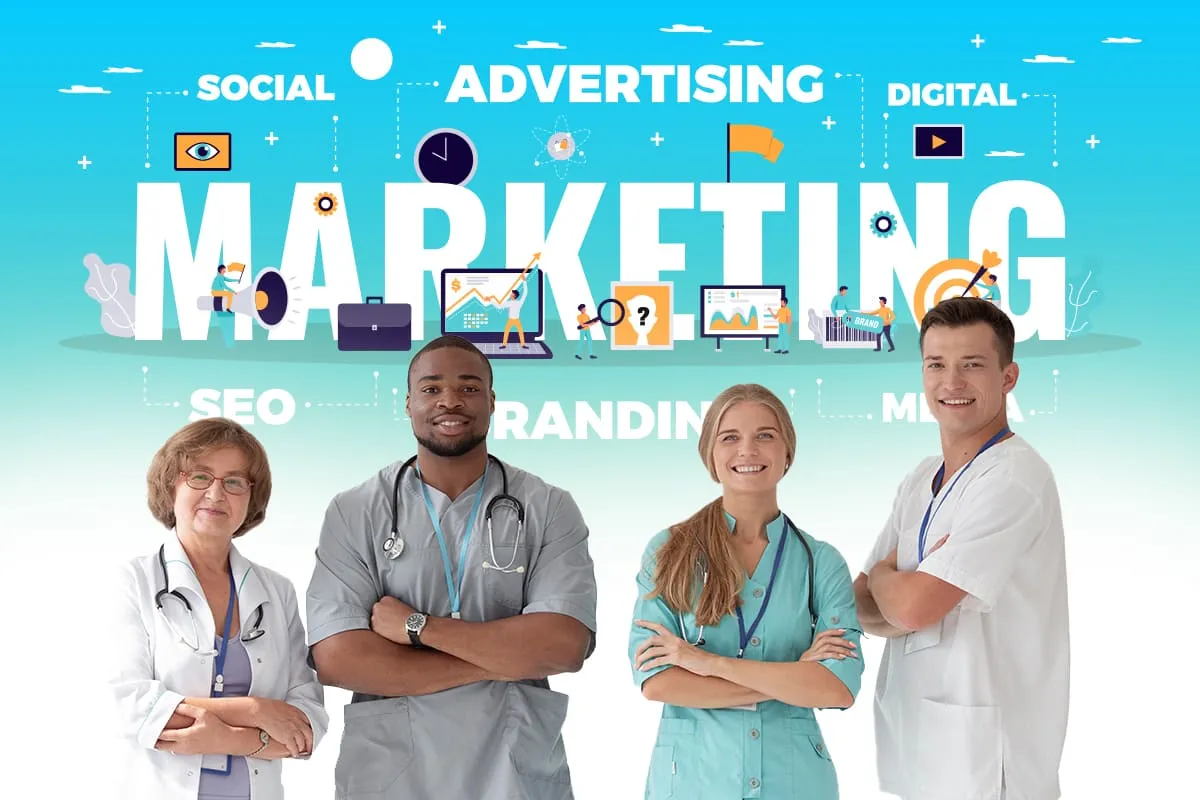Healthcare Marketing Strategies & Planning Guide
In the current competitive healthcare environment, a sound marketing strategy is no longer a choice, but a necessity. Patients are now researching clinics, hospitals, and health care providers online prior to making decisions. The healthcare marketing plan is the map that will help your practice to reach patients, gain their trust, and grow in a sustainable way.
We are MediVerticals, and we focus on assisting healthcare providers in designing patient-centered marketing approaches that will result in visibility, credibility, and expansion. This is a comprehensive guide on the entire range of healthcare marketing, including planning and strategy, implementation, measurement, and continuous improvement. All of this emphasizes the importance of healthcare marketing.
Table of Contents

What is a healthcare marketing plan?
A healthcare marketing plan is an action plan that is both detailed and actionable, and it describes your plans on how to attract, engage, and retain patients. In contrast to general marketing plans, the healthcare marketing plan should consider regulatory compliance (HIPAA, patient confidentiality), ethical issues, and specific communication requirements of patients.
The most important reasons why a marketing plan is important:
- Patient-Centered Approach: Healthcare marketing should be appealing to the needs and concerns of patients and explain your services in a clear way.
- Uniformity in Channels: On your site or social media, uniformity builds brand trust.
- Efficient Resource Allocation: Assists in the efficient allocation of budget for marketing, personnel, and technology.
- Measurable Impact: Set standards to measure ROI and optimize campaigns.
Real-Life Case: A small dentist office developed a systematic healthcare marketing strategy, such as search engine optimization, social media, and patient referral programs. They experienced a 35% growth in new patient appointments in six months, which proves that a properly developed plan has a direct positive influence on growth.
In the absence of a plan, the most well-intended campaigns will be inefficient, inconsistent, and fail to engage patients. An organized strategy will turn marketing into an engine of growth that can be measured.

Why Healthcare Marketing Is Essential for Today’s Practices
Healthcare marketing does not just involve filling appointment slots. Still, it is about creating relationships, trust, and credibility while putting your practice in a position to succeed in the long term.
According to Craig Samitt, M.D. We’ve got a lot of data in the industry, and not a lot of information. Understanding important elements of data for the purposes of maximizing quality and lowering the cost of care is just a weakness that everyone has.
Benefits for Patients
Marketing enhances patient experience:
- Better Access to Care: Patients will be able to access information about services, online booking, and telehealth more easily.
- Greater Trust: Transparency, educational material, and open communication will help patients feel that your practice is concerned with their well-being.
- Improved Communication: Patients are informed and entertained through newsletters, social media, and blogs.
- Informed Decision-Making: Patients who receive more information about procedures or preventive care make confident decisions.
- Patient Empowerment: Patients should be empowered through marketing that offers practical tips, guides, and health education that allows them to take charge of their health.
Scenario: A cardiology clinic develops a set of video tutorials about heart-healthy lifestyle habits. These videos allow patients to view them at home, become more confident about their lifestyle changes, and become more willing to make preventive checkups.
Doctor and Healthcare Provider Benefits.
Healthcare providers will benefit greatly:
- Growth of Practice: Recruit new patients and keep current patients by reaching out to them.
- More Visibility: Be visible in online search engines, social media, and local directories.
- Improved Reputation: Patient testimonials, thought leadership, and positive reviews lead to a better reputation.
- Data-Driven Insights: Data analytics can be used to understand patient preferences, which can be used to provide better services and optimize marketing.
- Operational Efficiency: Focused marketing campaigns decrease wasted money and optimize the booking of appointments.
Proven Healthcare Marketing Strategies You Can Use
The strategies listed below assist practices in attracting, engaging, and retaining patients as well as gaining credibility. In every section, there are examples and tips to be taken.
According to McKinsey & Company, satisfied patients are 28 percent less likely to switch providers.” This reinforces that marketing ROI is tied to improving the patient’s end-to-end experience, not just acquiring the first visit.
Strengthen Your Online Presence.
The first impression of your practice that patients have is usually created by your site, and it is crucial to focus on some main points. Search engine optimization (SEO) is an important factor to consider- local keywords like cardiology clinic in [city] can be a great way to increase visibility in the search results. As the majority of patients are looking to find healthcare services on their smartphones, mobile-friendliness is also to be considered. Trust and engagement can also be improved with a patient-centric approach to the content, such as including FAQs, staff profiles, detailed descriptions of the services, and online booking options to make a patient feel informed and supported.
Accessibility cannot be ignored, either, since compliance with the ADA standards will help you make sure that your site is effective with all patients. Lastly, it is essential to have good web performance- quick loading websites provide a good user experience and lower the bounce rates. The next step in enhancing engagement is to consider the addition of chatbots or virtual assistants, which can answer patient questions in real time and help schedule appointments.
Case Study: A dermatology practice has redesigned its website with SEO-friendly content, mobile optimization, and an online booking system. In three months, the traffic to the websites grew by 40%, and the number of appointments booked grew by 25%.
Share Valuable Content Through Blogs & Articles
Blogs and articles are one the searched items that a patient has of your practice on your site, so it must be user-friendly and interesting. Local search optimization, mobile-friendliness, and patient-centered information such as frequently asked questions, staff bios, and the ability to book online create trust, whereas ADA compliance and speedy page loading enhance user experience. Appointments can also be made easier by adding chatbots or virtual assistants. Content marketing adds to your credibility, educational content on health conditions, treatments, and preventive care, patient testimonials, and images such as infographics, making complicated topics easier to understand and increasing trust. Frequent blogging and calls-to-action ensure patients are kept on their toes- one physiotherapy clinic has experienced a 30% increment in new consultations in six months through giving tips on home workouts and rehabilitation.
Engage Patients with Social Media
Social media enables your practice to reach out to the community with educational material, news, and staff features. Interactive campaigns like Q&As, polls, or competitions, as well as brief video clips, can be used to engage the patients and ensure further interaction. Following up and replying to comments and messages keeps a personal contact with your audience. To achieve optimal success, each platform should be customized: Instagram is better with images and short videos, LinkedIn is better with professional information, and Facebook is better with communities.
Boost Reach with Paid Ads (Google, Facebook, LinkedIn)
Advertising will make your practice much more visible. Google Ads are useful to target patients who actively seek local services, Facebook Ads are better to use in seasonal campaigns or patient stories, and LinkedIn Ads are used to target professionals to form partnerships or target particular services. To achieve the best outcomes, A/B test advertisements, retarget former visitors of the website with follow-up campaigns, and make sure that all the content is HIPAA-compliant and ethically shown.
Example: A local dental clinic had specific Facebook and Google ad campaigns where teeth whitening services were promoted. The campaigns also created a 50% rise in inquiries in two months.
Build Trust Through Reviews & Reputation Management
Patient decisions are highly affected by online reviews. Ask happy patients to leave feedback on websites such as Google, Healthgrades, as well as Yelp, and address any negative comments in a timely and professional manner. Testimonials on your site and social media can also help to build trust. Indicatively, a children’s hospital, which posted parent reviews on Instagram and Facebook, experienced a 35% growth in patient interaction and a 20% growth in new appointments in three months.
Stay Connected via Email & Newsletters
Email marketing will keep patients interested in the service by updating them on the service, health tips, and seasonal offers. Personalized messages can be achieved by segmenting your patient list, and automated appointment reminders and follow-ups can help with retention. Continued patient engagement can also be promoted by the use of behavioral triggers, e.g., reminding patients using the history of prior appointments.
Harness the Power of Video for Patient Education
The video is very captivating and creates trust. Patients feel informed and connected with the help of procedure explainer videos, patient success stories, and facility and staff tours. These videos can be shared on social media, in email campaigns, and on your website to increase engagement and build trust with patients.

Step-by-Step: Creating Your Healthcare Marketing Plan
Define Your Goals
Clear measurable objectives are essential:
Increase the number of new patient appointments by X% within six months.
- Increase online review scores by 20%.
- Increase the coverage of the specific local communities.
Hint: Be specific, measurable, achievable, relevant, and time-bound with SMART goals.
Understand your patients’ needs
Collect data through surveys, analytics, and social listening:
- Demographics and preferences.
- Pain points and concerns.
- Favorite channels of communication.
Case in point: A family clinic found out that 70% of its clients wanted to make appointments through mobile applications, which resulted in creating a simplified mobile booking system.
Choose the Right Channels
Channels depending on your target audience:
Website and SEO: To be seen naturally.
- Social Media: Social awareness.
- Email & SMS: Retention and reminders.
- Offline Marketing: Local events, sponsorships, or referrals.
Pro Tip: Monitor the performance of each channel and redistribute the resources to the most efficient ones.
Set a Realistic Budget
Allocate resources wisely:
- Paid advertising (Google, social media).
- Creation of content (blogs, videos, infographics).
- Email automation and reputation management.
Hack: Begin with a test budget, measure outcomes, and increase campaigns according to ROI.
Track, Analyze, and Adjust
Use KPIs to refine campaigns:
- Traffic, conversions, and engagement metrics on the websites.
- Social media and ad performance.
- Patient acquisition and retention.
Such sophisticated tools as CRM systems, Google Analytics, and email marketing platforms are offering in-depth information to streamline your marketing strategy.

How to Measure Success in Healthcare Marketing?
Measure campaigns on the basis of the following metrics:
- Patient enquiries and appointments: Monitor conversion rates.
- Website traffic and activity: Track page views, bouncing rates, and time spent on the site.
- Reputation scores and reviews: Measure satisfaction and presence on the internet.
- ROI: Compare revenue earned and marketing expenditure.
Frequent measurement will help keep campaigns effective, relevant, and patient-centered.
According to the Centers for Medicare & Medicaid Services, hospitals must now align their marketing campaigns with available price data, moving away from vague cost messages toward clear, comparative value. The Government Accountability Office (GAO) noted that CMS initiated 1,287 enforcement actions from 2021 through 2023, issuing over $4 million in civil monetary penalties to non-compliant hospitals.
Final Thoughts: Building Trust While Growing Your Practice
Healthcare marketing is aimed at the development and establishment of patient trust. A patient-centered approach will help make sure that your practice is reaching the right audience, building trust and loyalty, and staying competitive in the current digital-first healthcare landscape. Such sites as MediVerticals can assist healthcare providers in building their marketing activities in a responsible, ethical, and effective way.
FAQs
What are the major elements of an effective healthcare marketing strategy?
An effective plan consists of patient personas, SMART objectives, multi-channel strategies, content development, reputation management, compliance, and performance measurement. It must be consistent, transparent, and patient-centered.
How do healthcare marketing strategies and a healthcare marketing plan differ?
A strategy outlines the what and why, objectives, and target market. The tactical roadmap is a marketing plan that outlines the steps to be executed, timelines, budgets, and metrics to be used in the execution of the strategy.
What is the significance of healthcare marketing strategies to the medical practices?
The marketing strategies guarantee the acquisition of patients, retention, and building trust. They enhance visibility, maximize communication, and assist practices to be competitive and deliver quantifiable outcomes.
What is a healthcare marketing plan supposed to consist of?
It should have a plan with goals and patient research, channel selection, content strategy, budget, timelines, KPIs, and compliance measures. The ability to maximize impact is based on continuous analysis and adaptation.
What are the best healthcare marketing strategies to engage the patients?
Social media campaigns, online reviews, video education, content marketing, email newsletters, and paid advertising are very effective. Patient-centered, multi-channel strategies lead to engagement, retention, and trust.
